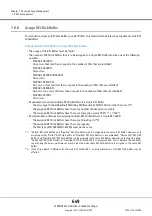
Chapter 7 Advanced Copy Management
7.8 REC Management
ETERNUS Web GUI User’s Guide (Settings)
Copyright 2015 FUJITSU LIMITED
P2X0-1270-13ENZ0
646
Requirements for selecting drives
•
The requirements for a RAID group that is to be used as an REC Disk Buffer are as follows:
-
The number of member drives is four or eight
(The RAID level for the REC Disk Buffer is RAID1+0(2+2) for four member drives or RAID1+0(4+4) for
eight member drives.)
-
Do not combine different drive types (Online/Nearline/SSD/Online SED /Nearline SED/SSD SED)
(Although "Online" type drives and "Nearline" type drives can be used in the same REC Disk Buffer,
using only "Online" type drives or using only "Nearline" type drives is recommended. Also, "Online SED"
type drives and "Nearline SED" type drives can be used in the same REC Disk Buffer, but using only
"Online SED" type drives or using only "Nearline SED" type drives is recommended. This is because the
available capacity and the access performance may be reduced when these drives are used in the same
REC Disk Buffer.)
-
The drive size must be smaller than 6TB (except SSDs and SSD SEDs)
•
The recommended drive configuration of the RAID group is shown as follows:
-
Select drives with the same capacity. If drives of different capacities exist in a RAID group, the smallest
becomes the standard, and all other drives are regarded as the same capacity as the smallest drive. In
this case, the remaining drive space is not used.
-
Select drives with the same speed. If drives of different speeds exist in a RAID group, access
performance of the RAID group may be affected.
-
SSD types vary depending on the interface speed (bandwidth). When manually specifying SSDs to be
used, it is recommended to select SSDs with the same type (SSD-M/SSD/SSD-M SED). If different types
of SSDs exist in a RAID group, the access performance for all SSDs in the RAID group is adjusted to the
SSD of the lowest interface speed.
-
If the host connection environment does not support Advanced Format (AF), select non-AF-compliant
drives (*1). If AF-compliant drives (*2) are selected, a data format conversion occurs and the drive
access performance is reduced. When the host to be connected supports AF, both AF-compliant and
non-AF-compliant drives can be selected.
*1:
Drives (such as 2.5" Online, 2.5" Nearline) where "AF" is not displayed for the type.
*2:
Drives (such as 2.5" Online AF, 2.5" Nearline AF) where "AF" is displayed for the type.
-
Allocate the mirroring pair drives by dividing them into two or more connection lines (for the ETERNUS
DX500 S3/DX600 S3).
•
There are conditions for the ETERNUS DX8700 S3/DX8900 S3 drive layout. Refer to
ETERNUS DX8700 S3/DX8900 S3 drive layout" (page 528)
for details. These conditions apply when the RAID
level is "High Performance (RAID1+0)".
For details on the parameters for this function, refer to
"A.7.8 Create REC Disk Buffer" (page 962)
For the factory default settings for this function, refer to
"Appendix B Create REC Disk Buffer" (page 1011)
The procedure to create an REC Disk Buffer is as follows:
Procedure
1
Click [Create REC Disk Buffer] in [Action].
Содержание Eternus DX200F
Страница 2: ...This page is intentionally left blank ...
Страница 1082: ......
















































